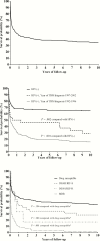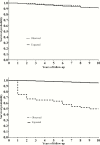Long-term Mortality of Patients With Tuberculous Meningitis in New York City: A Cohort Study
- PMID: 27927856
- PMCID: PMC5850536
- DOI: 10.1093/cid/ciw763
Long-term Mortality of Patients With Tuberculous Meningitis in New York City: A Cohort Study
Abstract
Background: Tuberculous meningitis (TBM) is the most devastating clinical presentation of infection with Mycobacterium tuberculosis; delayed initiation of effective antituberculosis therapy is associated with poor treatment outcomes. Our objective was to determine the relationship between drug resistance and 10-year mortality among patients with TBM.
Methods: We conducted a retrospective cohort study of 324 patients with culture-confirmed TBM, susceptibility results reported for isoniazid and rifampin, and initiation of at least 2 antituberculosis drugs, reported to the tuberculosis registry in New York City between 1 January 1992 and 31 December 2001. Date of death was ascertained by matching the tuberculosis registry with death certificate data for 1992-2012 from the New York Office of Vital Statistics. Human immunodeficiency virus (HIV) status was ascertained by medical records review, matching with the New York City HIV Surveillance registry, and review of cause of death.
Results: Among 257 TBM patients without rifampin-resistant isolates, isoniazid resistance was associated with mortality after the first 60 days of treatment when controlling for age and HIV infection (adjusted hazard ratio, 1.94 [95% confidence interval, 1.08-3.94]). Death occurred before completion of antituberculosis therapy in 63 of 67 TBM patients (94%) with rifampin-resistant disease.
Conclusions: Among patients with culture-confirmed TBM, we observed rapid early mortality in patients with rifampin-resistant isolates, and an independent association between isoniazid-resistant isolates and death after 60 days of therapy. These findings support the continued evaluation of rapid diagnostic techniques and the empiric addition of second-line drugs for patients with clinically suspected drug-resistant TBM.
Keywords: drug resistance; multidrug resistance; treatment outcome; tuberculosis; tuberculous meningitis.
© The Author 2017. Published by Oxford University Press for the Infectious Diseases Society of America. All rights reserved. For permissions, e-mail: journals.permissions@oup.com.
Figures



References
-
- Thwaites GE, van Toorn R, Schoeman J. Tuberculous meningitis: more questions, still too few answers. Lancet Neurol 2013; 12:999–1010. - PubMed
-
- Van TT, Farrar J. Tuberculous meningitis. J Epidemiol Community Health 2014; 68:195–6. - PubMed
-
- World Health Organization. Treatment of tuberculosis guidelines. 4th ed Available at:http://apps.who.int/iris/bitstream/10665/44165/1/9789241547833_eng.pdf Accessed 7 March 2016.
-
- Ruslami R, Ganiem AR, Dian S, et al. Intensified regimen containing rifampin and moxifloxacin for tuberculous meningitis: an open-label, randomized controlled phase 2 trial. Lancet Infect Dis 2013; 13:27–35. - PubMed
MeSH terms
Substances
Grants and funding
LinkOut - more resources
Full Text Sources
Other Literature Sources

